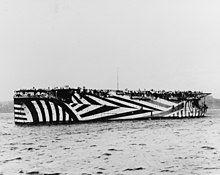HMS Argus (I49)
|
||||||||||||||
|
||||||||||||||
|
||||||||||||||
|
||||||||||||||
The HMS Argus (I49) was the first real aircraft carrier of the British Royal Navy to be completed before the end of the First World War . The Argus was a conversion of a half-finished passenger ship originally started as the Conte Rosso of the Lloyd Sabaudo line. This was laid on the keel at the William Beardmore and Company shipyard in Dalmuir near Glasgow and construction was then discontinued. The navy acquired the half-finished ship, which was built as an aircraft carrier. The ship was launched on December 2, 1917, and on September 16, 1918, the ship was put into service.
The ship was a carrier of the "islandless" type, a smooth deck carrier , that is, the flight deck was an area over the entire deck of the ship without any superstructures. Originally, superstructures were planned that would have separated the flight deck into two areas - the runway. The area for take-off would have been in front of and the area for landing behind the superstructures in the middle, but experience with the Furious had shown that the air turbulence caused by the superstructures made landing very dangerous and difficult. For this reason, superstructures were dispensed with in favor of a continuous flight deck. Since there was no chimney due to this design, the smoke gases from the steam engines of the ship were led under the flight deck to the stern of the ship, where they could escape under the end of the flight deck. There was a retractable steering position in the front of the flight deck. At cruising speed , the ship was controlled from, and flight operation of the control supernatant was sunk flush with the flight deck.
Below the flight deck was the hangar deck, which was on the main deck level of the ship. To transport the aircraft from the hangar to the flight deck and back, there were two elevators of different sizes with the dimensions 11 × 9 meters at the rear and 18 × 5.5 meters at the front.
The Argus was first used in the summer of 1919 when she was transporting aircraft to Murmansk for the British intervention forces . Between 1925 and 1926 she was equipped with additional torpedo protectors ( torpedoes did not explode with proximity fuses under the keel to break them, but hit the hulls and mostly had impact fuses) in order to improve their survivability in combat. As the original passenger ship, the ship was not armored.
After this conversion, she served in the Atlantic , in the Mediterranean and on the " China Station ". She was transferred from active duty to the reserve in Portsmouth on May 7, 1930 . On May 28, 1938, she was returned to active service as a training ship for pilot training, where she was used for training on deck landings and takeoffs. A catapult for remote-controlled target aircraft was also installed for fighter pilot training, but this task was secondary. During the Second World War she was still a training ship and was also used as a transporter for aircraft, including to North Africa , Malta and Murmansk. She was also the escort of several convoys in the North Atlantic. During Operation Torch (the Allied landing in French North Africa ) it was damaged by a bomb from a German plane.
When it became clear in 1944 that the general condition of the ship was so bad that it could no longer remain in active service, it was decommissioned on October 21, 1944. It then served as a barge in Chatham until December 5, 1946, when it was sold for scrapping, and was scrapped in Inverkeithing in 1947 .

